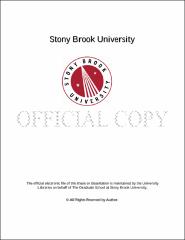| dc.identifier.uri | http://hdl.handle.net/11401/77284 | |
| dc.description.sponsorship | This work is sponsored by the Stony Brook University Graduate School in compliance with the requirements for completion of degree. | en_US |
| dc.format | Monograph | |
| dc.format.medium | Electronic Resource | en_US |
| dc.language.iso | en_US | |
| dc.publisher | The Graduate School, Stony Brook University: Stony Brook, NY. | |
| dc.type | Thesis | |
| dcterms.abstract | A major problem in neuroscience is determining the perceived value of rewarding and aversive stimuli in animal subjects. Orofacial activity, such as licking and gaping in response to tastes, has been shown to be well correlated with the perceived palatability of tastes sampled by an animal. The current standard for determining these orofacial reactions is frame-to-frame labeling by trained scientists, a very time consuming process. Here we introduce a supervised classifier that can automatically recognize nine distinct yet subtle orofacial activities with an accuracy of 82.00% (chances are 21.16%). The classifier implements data from both videos of rats receiving taste deliveries and concurrent electromyographic recordings of the digastric muscle which is involved in food consumption. We additionally applied our classifier and features to a classical conditioning experiment to determine whether cues predicting different tastes can initiate different orofacial movements prior to an actual taste delivery. By using features extracted following the cue (tone) but before the corresponding taste delivery, we can predict the identity of the cue with an accuracy of 41.39% (chances are 20.11%), showing that the animals have learned the cue-taste associations. In addition, we can retroclassify the identity of the cue with an accuracy of 65.64% using features extracted after the taste delivery. Based on these results, we claim that our model allows for fast and objective determination of orofacial reactions in rats and for assessing the strength of taste-reinforcer associative learning. | |
| dcterms.available | 2017-09-20T16:52:21Z | |
| dcterms.contributor | Samaras, Dimitris | en_US |
| dcterms.contributor | Fontanini, Alfredo | en_US |
| dcterms.contributor | Gu, Xianfeng. | en_US |
| dcterms.creator | Hou, Le | |
| dcterms.dateAccepted | 2017-09-20T16:52:21Z | |
| dcterms.dateSubmitted | 2017-09-20T16:52:21Z | |
| dcterms.description | Department of Computer Science. | en_US |
| dcterms.extent | 43 pg. | en_US |
| dcterms.format | Application/PDF | en_US |
| dcterms.format | Monograph | |
| dcterms.identifier | http://hdl.handle.net/11401/77284 | |
| dcterms.issued | 2015-08-01 | |
| dcterms.language | en_US | |
| dcterms.provenance | Made available in DSpace on 2017-09-20T16:52:21Z (GMT). No. of bitstreams: 1
Hou_grad.sunysb_0771M_11748.pdf: 1156839 bytes, checksum: 45dc12ed1748019b590169194600a7aa (MD5)
Previous issue date: 2014 | en |
| dcterms.publisher | The Graduate School, Stony Brook University: Stony Brook, NY. | |
| dcterms.subject | Automatic Recognition, Classical Conditioning, Machine Learning, Orofacial Activity | |
| dcterms.subject | Computer science | |
| dcterms.title | Rat's Orofacial Activity Recognition and Its Applications | |
| dcterms.type | Thesis | |

